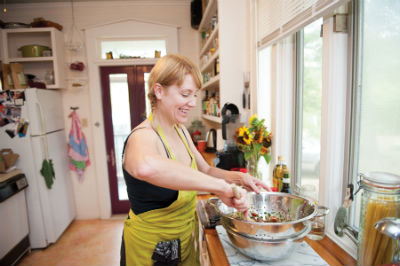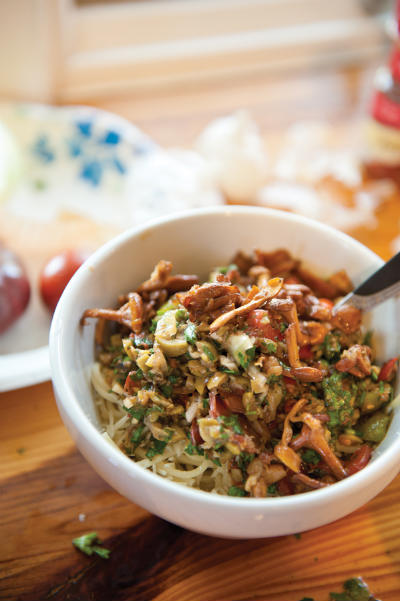“I bought this place [in Bush, Louisiana] at the end of October. My boyfriend has an organic farm near here and we deliver vegetables to restaurants in New Orleans—Maurepas, Mariza and Brigtsen’s. Right now, we’re mainly harvesting tomatoes, squash and okra.
Do you want me to give you a tour of the garden? These are going to be mammoth sunflowers, and I have strawberries over here. I just planted night-blooming jasmine, and these are all melons, different varieties.
Whatever we don’t sell at the farmers’ market on Saturdays, I’ll put in the crocks and ferment. Lacto-fermentation is an ancient form of preservation, and it’s much healthier than regular pickled things with vinegar, which kills all the beneficial bacteria.
[Walking through field.] These are eggplants; that’s dill—I use dill for fermentation a lot—and these are Tennessee dancing gourds. These are persimmons, that’s pomegranate, and these are rare figs. These are apples that I planted, and those are pears; wild huckleberries, like blueberries but very small. We’re going to harvest some basil, just enough for lunch. A restaurant will order ten pounds sometimes, and it takes forever to harvest that much because basil’s so light.
Here’s my citrus garden. Lemon, kaffir lime, ruby grapefruit and this is a navel orange that I found between here and my hometown Alexandria. I get up at 6 a.m. and work in the garden or at the farm all day, and then at night, we’re shelling red beans until we pass out.
My grandmother died six weeks ago and my sister and I were visiting her in hospice and talking about kumquats because we ate a lot of kumquats when we were kids, so when I was driving back, I picked up a kumquat plant. And it bloomed, I mean, it had more flowers on it than it had leaves! There are a lot of cool preservation things you can do with kumquat. Most of what we eat we’ve caught or farmed. We have traps out for channel catfish but we also go bass fishing. We have crawfish traps in the creek too.
My favorite is growing things from seed. The tomatoes we’re about to use, I knew them when they were seeds. There is something really cool about seeing their progress, taking care of them and watering them, and then eating them.
There wasn’t a whole lot of cooking going on in my family, but both my grandmothers were great cooks—lots of greens, cornbread, gumbo and slow-cooked roast. Not sure what happened with my parents [laughs]. For me, it’s been trial and error. My boyfriend’s mom is an excellent cook, but I made the mistake of telling her early on in our relationship that I couldn’t cook. The look of horror on her face! And she’s Sicilian—Sam Butera was her uncle—and the tomatoes we’re using today are the old-world heirloom tomatoes that the Buteras used, really cool, Genovese tomatoes.
I make fish tacos a lot, red beans and white bean soups, stuff like that. And Summer Spaghetti is my favorite dish. It tastes amazing and it’s all fresh and you don’t have to cook it, so the kitchen stays cool. You can make a lot of it and let it sit in the refrigerator for a few days, and now that I grow most of the ingredients, this makes it even better.”
Summer Spaghetti
Ingredients:
- 1 pound tomatoes, chopped
- 1 small onion, minced
- 2 cloves garlic, minced
- 8 ounces green olives, sliced
- 1 teaspoon paprika
- 1 tablespoon dried oregano
- 1/2 bunch fresh parsley, chopped
- 2 large handfuls fresh basil, chopped
- 3 tablespoons red wine vinegar
- 1/2 cup olive oil
- 1 pound spaghetti
- Parmesan or Romano cheese, grated
Directions
- In a colander (to drain off some of the tomato juice), mix all the vegetables and pour any olive juice over them (for salt), letting the juice go through.
- Transfer to a large bowl and season with spices, herbs, vinegar and oil.
- Cover and let sit for at least 30 minutes.
- Boil spaghetti.
- Serve hot pasta with grated cheese and vegetable mix on top. (Linnzi also had some fresh chanterelles, which she sautéed in a frying pan in olive oil for a few minutes and put on top.)
NO MORE GRAVY!
This is the last article in the series that I’ve been doing every month since September 2008. It’s been a great run—we’ve featured 59 cooking musicians—and the pot is far from empty. You can get the book, The Gravy—In the Kitchen with New Orleans Musicians (2013), based on this column, and we’re currently planning a new series we’ll debut next month in our annual food issue, combining Louisiana music, food and drink in a new way.—Elsa Hahne






